






ANDREW GAPINSKI
Welcome to the beauty of late summer at the Arboretum! As the height of the growing season slowly gives way to fall, the gardens, crop plots and orchards across the Arboretum are bursting with life, color and produce!
At the Horticultural Research Center, the Farm at the Arb and in the Home Demonstration Gardens, a bountiful harvest is ready after a full growing season of sun, heat and care from Farm apprentices, volunteers and staff.
Be sure to stop by the Home Demonstration Gardens on your next visit to find inspiration for your own veggie or herb garden. These areas, designed to inspire home gardeners, are at the height of their beauty this time of year. In this issue, learn about five showstopping ornamental edible
AUGUST/SEPTEMBER 2024, VOL. 43, N O 4
plants the Horticulture team is growing this season that you might consider for your own landscape.
At the Farm at the Arb, we’re not only harvesting a bounty of produce, but also honey from the hives at the Tashjian Bee and Pollinator Discovery Center. Learn about beekeeping at the Arboretum — and the honey harvest — from beekeeper Ping Honzay on page 7. Then, on Sept. 7, celebrate the harvest season with us at Field Fest at the Farm — our annual family-friendly event that embraces all things agriculture.
We’re also looking forward to the seasonal opening of the AppleHouse in late August. It’s a fitting time to celebrate fruit breeding research at the HRC and honor the legacy of Professor Jim Luby, who retires this August after 42 years at the helm of the program that has led to introductions including Honeycrisp, SweeTango® and First Kiss® apples. You can read more about Jim’s distinguished career in the fruit breeding and genetics program on page 6. Finally, be sure to visit the fourth-annual Arboretum Glass Pumpkin Patch taking place Sept. 13-15, where art meets nature in a delightful display of glass pumpkins and garden art all in support of the Arboretum.
We hope to see you out enjoying the harvest season at the Arboretum soon!
Arboretum Magazine is published by the Minnesota Landscape Arboretum. The Arboretum is part of the College of Food, Agricultural and Natural Resource Sciences (CFANS) at the University of Minnesota. The magazine is a benefit of Arboretum membership. To request a copy of this publication in an alternate or digital format, please call 612-301-1257.
© 2024 Regents of the University of Minnesota. All rights reserved. The University of Minnesota is an equal opportunity educator and employer.
Elise Bremer, Editor
Brenda Drake Lesch, Art Director
Andrew Gapinski, Executive Director
Matthew Clark, Ph.D., Director of Research
Rachelle Crosby, Director of Facilities & Project Management
Timothy S. Kenny, Director of Education
Jared Rubinstein, Director of Horticulture & Collections
David Senior, Director of Business & Finance
Susan Taylor, Ph.D., Director of Advancement
Tom Lany, Senior Marketing & Communications Manager
Glenn Stolar, President, Arboretum Foundation arb.umn.edu 612-624-2200 arbinfo@umn.edu
Each year, dazzling new varieties are put to the test
ELISE BREMER • EDITOR
In late summer, dahlias in fiery hues and rich jewel tones steal the show in gardens across the Arboretum. But tucked away in orderly rows in a fenced garden along Three-Mile Drive, neverbefore-seen varieties of dahlias are grown and evaluated each summer in the Dahlia Trial Garden.
Established at the Arboretum in 1971 by the Minnesota Dahlia Society, the North Central Dahlia Trial Garden is one of eight official dahlia trial gardens in North America, growing and evaluating new, unnamed hybrid varieties of dahlias sent in by hybridizers from across the country. The hybridizers’ aim is to develop the newest exhibition-worthy blooms for competition growers — like those you might see adorned with blue ribbons at the Minnesota State Fair.
The trial garden is maintained by members of the Dahlia Society who weed, water, pare back foliage and disbud flowers (remove superfluous buds) as the plants mature. Finally, at the end of the season, blooms are carefully evaluated by American Dahlia Societycertified judges based on seven unique characteristics: Form, color, substance, stem, foliage, bloom position and floriferousness (how
many flowers the plant produces). Dahlias with a winning combination of these traits are then recommended to the American Dahlia Society for classification and inclusion in their handbook.
A bit closer to the main gardens of the Arboretum, just behind the Snyder Building, the Arboretum’s Dahlia Display showcases dozens of popular varieties of commercially available dahlias for visitors to consider for their home gardens. The dahlias in this display are carefully staked to support the massive flower heads that top towering stems, but other than that, the plants in this display are grown with minimal maintenance and pruning, as they would be in the home garden.
Dahlias are not winter hardy in Minnesota, and the tubers must be dug up and stored away from frost over the winter months. But for dahlia enthusiasts, the extra bit of care and maintenance is well worth the masses of vivid blooms that light up the landscape.
Visit the Dahlia Trial Garden this season to view the latest introductions to the dahlia world or stop by on Saturday mornings to chat with the members of the Dahlia Society who maintain the trial garden. To learn more about the Minnesota Dahlia Society visit minnesotadahliasociety.org.
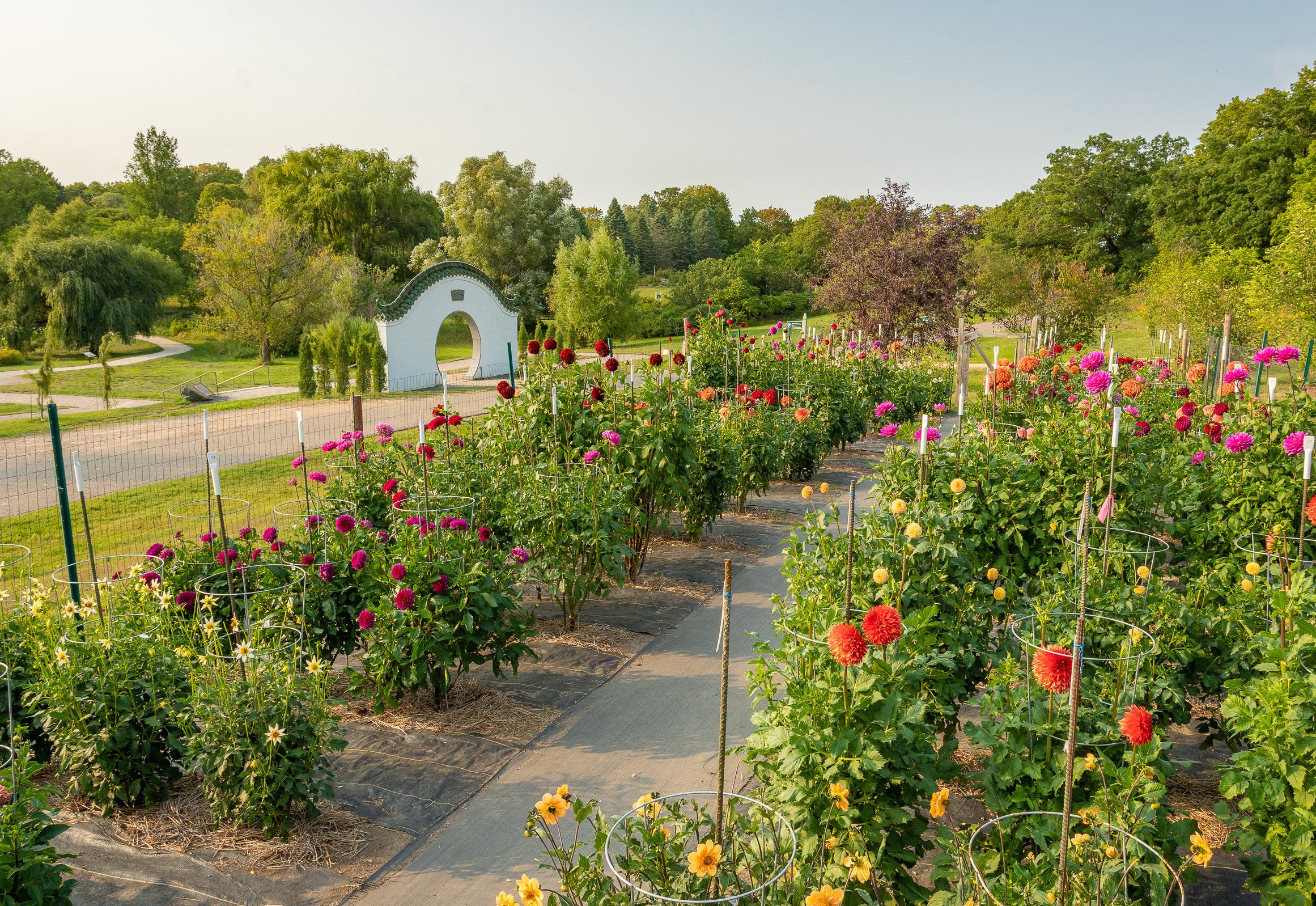
MATT SCHUTH • NATURALIST
From the sultry days of late July and onward to the cooling days of September, the king of the meadows, Joe Pye weed, rises above the surrounding vegetation. Its stalks can grow 7 to 8 feet tall and dominate the transition zone between water and land plants. Joe Pye weed can withstand the fiercest blizzards of winter, towering over the wetlands like giant brown sentries.
The plants are crowned with a composite cluster of tiny vanilla-scented purplish-pink flowers, the rich, fragrant nectar of which is a magnet for pollinators, including the threatened rusty-patched bumblebee. In late autumn, the soft wooly gray parachuted seeds of Joe Pye weed are dispersed by the wind. In spring, new stems arise from perennial rhizomes. These rhizomes produce a thick mass that forms loose marsh soil into land.
The genus name of Joe Pye weed, Eutrochium, is derived from Greek and means “wheel-like.” Leaves are arranged in a whorl of four, with each leaf slightly rotated from the leaf above and below, which allows for maximum sunlight to reach each leaf.
The name Joe Pye weed is thought to have originated from a Mohican tribal leader and herbalist who is said to have used the plant to cure typhoid fever, though historical evidence to confirm the origin of the plant’s name is hard to come by. Whatever the origin of the name Joe Pye weed, various histories suggest that the plant was well known to Indigenous communities for its medicinal value.
The leaves of the plant were made into a tea to induce sweating and lower fevers such as typhoid fever, and the Meskwaki, or Fox tribe, believed the plant could lend a young man luck in love. The Potawatomi peoples believed the flower head to be a good luck charm.
The real story of the name Joe Pye weed may be lost to history, but its benefits to humans and other species, including pollinators, are wellremembered and appreciated. Find Joe Pye weed at the Arboretum in sunny or partially shaded wet meadows, such as around Green Heron Pond, as well as at the Tashjian Bee and Pollinator Discovery Center at the Farm at the Arb.

JEFF ISEMINGER • CONTRIBUTING WRITER
“I haven’t been everywhere,” said writer Susan Sontag, “but it’s on my list.”
Sontag’s love of travel seems to capture the personal zeitgeist of Denis Bakke, who has been, shall we say, around the block and back.
Just for starters, he’s been to all 50 states and the District of Columbia. “It’s such a beautiful country,” he said.
Not only that, he’s participated in no less than 24 Arboretum Garden Travel Tours around the world. If they were ice cream flavors, he’s tasted Peru-Canada Crumble and Italy-Argentina Ripple and EcuadorBelgium-Netherlands Cookie Dough, plus a slew of other travel tastes.
His first trip with the Arboretum took him to Chile, three years after the death of his wife, Phyllis Johnson. He had known Phyllis since they were in second grade together, and their marriage lasted 52 years.
“My travel has inspired me to plant on my own property in Lake Elmo,” said Bakke. He’s especially proud of his northern white cedars, planted 60 years ago and now 40 feet high.
There’s been another boon to being peripatetic, said Bakke: “Many of the people I’ve met through my trips have become my friends.”
Bakke’s ties to the Arboretum go way back, before its inception. As a student at the University of Minnesota in the 1950s, he took two courses from Dr. Leon Snyder. One of their field trips was to check out some land being considered for what became — you guessed it — the Arboretum.
Bakke, 92, has stayed engaged with the Arboretum for six decades. “It’s got a Walden Pond disposition,” he said. “You can get with nature there by walking down a trail slowly, stopping and listening,” much as the man who made Walden Pond well-known, Henry Thoreau.
Thoreau, like Bakke, was an inveterate traveler, and Bakke would cheer this Thoreauvian thought: “It matters not where or how far you travel … but how much alive you are.”
Being alive to the joys of travel, however near or far, has brought many blessings to Bakke. “I’ve had such a good life,” he said. Learn more about upcoming Garden Travel Tours at arb.umn.edu/travel
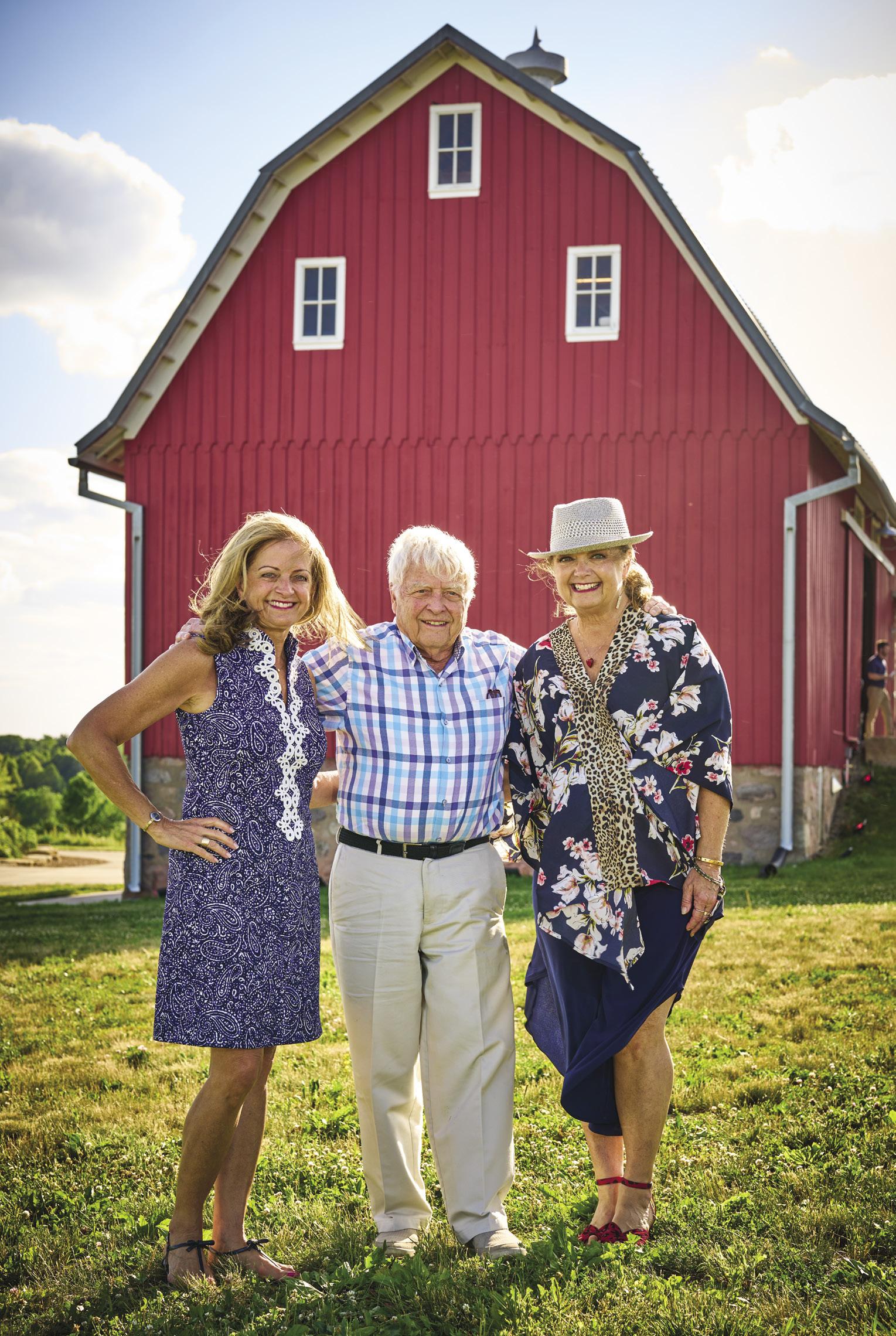
JULIE PETERS • COMMUNICATIONS STRATEGIST

As Professor Jim Luby concludes a distinguished 42-year career in the Department of Horticultural Science at the University of Minnesota, he leaves behind a legacy that extends from the classroom to the orchard.
As an undergraduate student, Luby’s first job was working for an oats breeder. “That gave me a look at what plant breeders do, and I thought, this looks really interesting and a good way to use the science that I love — and be outdoors, and hopefully do something useful for people.”
Much of Luby’s pioneering work took place at the Arboretum's Horticultural Research Center (HRC), the institution responsible for producing more than 160 plant introductions since 1908.
The fruit breeding program has introduced and commercialized 110 cultivars of apples, wine grapes, blueberries, strawberries and other fruits; 31 were introduced during Luby’s time at the HRC. The apple research has focused on the development of varieties that combine great taste with cold hardiness and disease resistance, blossoming into well-loved apple varieties, including Honeycrisp; Luby’s personal favorite, SweeTango®; and the latest introduction, Kudos®. Luby said the greatest advances in fruit breeding have occurred in the past 15 years with


the identification and increased use of DNA markers. “It gives us a lot more information that we can use in selecting and planning the crosses we are going to make, and — when we get seedlings — which ones are predicted to perform better than others.”
He treasured his time teaching and advising students — and also appreciated being able to dig in the dirt regularly. “Some of my fondest memories were when I could get out to the HRC and actually just work with the plants.”
Luby is also quick to credit the talented staff and students he’s worked alongside over the years. “We’ve had some great people at the HRC in managing orchards, vineyards, greenhouses, everything that’s needed to successfully do fruit breeding.”
Congratulations to Luby on a well-deserved retirement and “kudos” for his significant contributions to horticulture, academia and beyond!
Each year in August, we harvest honey from our honey bee hives at the Arboretum’s Tashjian Bee and Pollinator Discovery Center. And each year, I’m filled with a sense of wonder for the bees and pollinators in our world.
Honey is an incredible substance. It doesn’t spoil. You may have heard of honey unearthed from ancient Egyptian tombs that’s thousands of years old and still edible. It also has antimicrobial properties and has historically been used to help wounds heal.
The western honey bee is the only bee in North America that makes honey — making honey is a lot of work! The process is a great example of the power of a cooperative team. Each honey bee may make only about one-twelfth of a teaspoon of honey in her lifetime, but working together, the tens of thousands of bees in a hive can produce well over 100 pounds of honey in a year.
While honey bees get a lot of attention, there are more than 500 other species of bees in Minnesota. These bees range from large, cuddly-looking
bumble bees to bees smaller than a pinhead. There are bees with classic black and yellow markings, but also dark blue and metallic green bees. Some bees visit a wide range of flowers, while others specialize in pollinating just a select few. What all of these bees share though, is that they are performing a critical service for the plants that they visit — moving pollen between flowers so those flowers can produce seeds and fruit.
Pollinators like bees help sustain us. The obvious examples of this are by creating food, whether directly (as in honey) or indirectly (via pollination), and by helping plants to reproduce and thus sustain our environments. But they also help make life more enjoyable. Flowers have evolved a variety of beautiful colors, shapes and smells specifically to attract different pollinators. Many people find bees to be beautiful and fascinating as well!
To learn more, browse pollinator classes and events at the Arboretum at arb.umn.edu/pollinator-classes or stop by the Bee and Pollinator Center to watch pollinators foraging in the gardens — and to share in gratitude for pollinators and their wonderful work.

ELISE BREMER • EDITOR
Across the Arboretum’s gardens, fruits, vegetables and herbs are prized for their flavor — and their flair. By late summer, towering pole beans clamber up trellises in the Home Demonstration Gardens surrounded by crinkly kale, herbs and a wall of expertly espaliered Haralson apples.
In the Home Demonstration Gardens, visitors will find show-stopping edible plants selected by horticulturist Ted Pew for their taste and looks as well as disease resistance. Pew has managed these gardens since 1987 and selects only plants he knows he can count on to put on a show and produce a bounty of produce.
Many of the vegetables, herbs and flowers Pew plants are All-America Selections (AAS) winners that have been trialed by horticulture professionals in different zones throughout the country. Visitors can check out the Arboretum’s AAS Display Garden or stroll through the Home Demonstration Gardens to view a selection of AAS winners to consider for their home garden.
In the Foodscape at the Farm at the Arb, small fruit-bearing shrubs such as aronia dot the landscape alongside strawberries, blueberries and the more exotic, but completely winter-hardy, vining kiwiberry.
Whether your home garden consists of a few small containers of herbs or features a large veggie garden, growing your own food can be fun and rewarding, especially if the plants in question are doing double duty as ornamentals!
For those just getting started adding more food plants into the landscape, Arboretum-based Extension Horticulture Educator Laura IrishHanson recommends starting small and choosing plants “you know you like to eat!” After all, there’s no point in growing a whole bed of Swiss chard if nobody in your household will eat the stuff.
Find these five edible, ornamental and even downright unusual plants growing at the Arboretum this season, and be sure to add them to your seed shopping list for next summer!




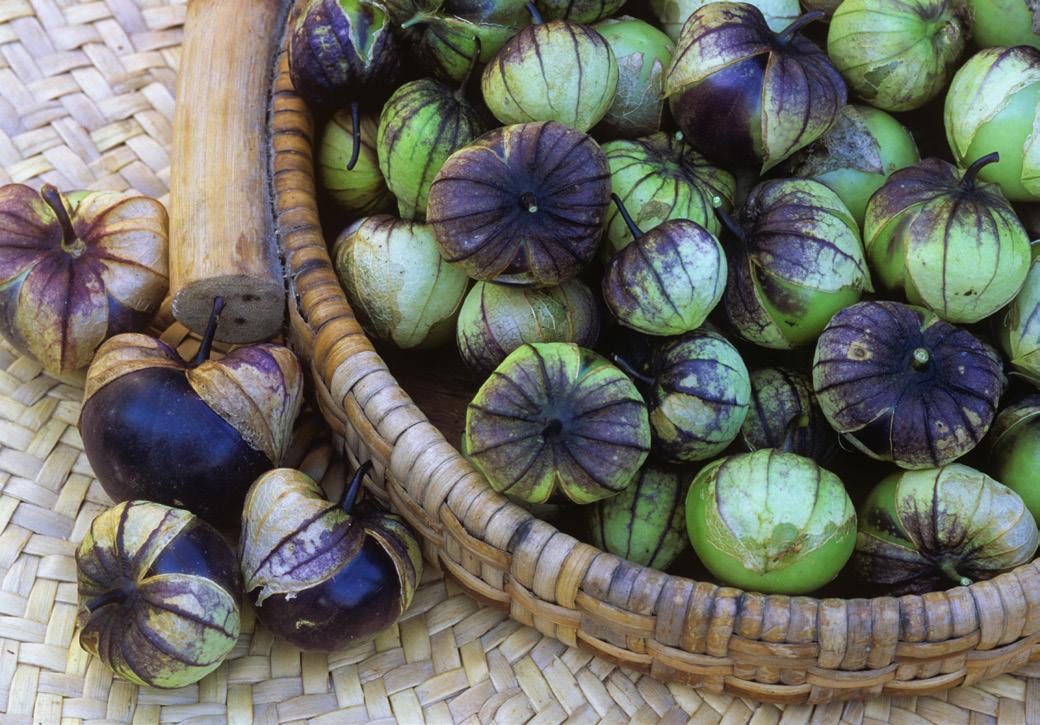
Basella alba 'Rubra'
Location:
Garden Gallery at the Farm at the Arb
Why we grow it: This heat-loving plant's bright red vining stems add a pop of color to any container or vegetable garden and easily clamber up a fence or trellis. While not a true spinach, the succulent leaves of Malabar spinach feature a peppery citrus flavor and can be used in fresh salads or soups. This year, the Garden Gallery at the Farm at the Arb was curated by Zongxee Lee and features plants that tell the story of her family who brought herbs — and the traditional knowledge of how to use them — from Laos to their new home in Minnesota.
Location:
Home Demonstration Gardens
Why we grow it: This 2017 AAS winner is prized for its unique look and the plant’s “vigor, earliness, high yields, large size and awesome taste,” which is citrusy, sweet and mildly spicy. The UFO-shaped fruits transition from green to red as they mature and can be harvested at any point, lending a multicolored splash to slaws or other summery dishes. Find this unusual and tasty pepper alongside other eyecatching ornamental edibles inspired by the character Lydia Deetz of the 1988 film “Beetlejuice.” The character’s quote — “I myself am strange and unusual” — inspired the whimsical planting scheme for this bed.
Location:
Foodscape at the Farm at the Arb
Why we grow it: Also known as blue honeysuckle or haskap, this attractive fruit-bearing shrub is extremely cold hardy, making it a perennial food crop and a beautiful addition to the landscape. The irregular-shaped blue fruits are high in vitamin C and feature a zingy flavor described as a cross between a blueberry and a raspberry. Check out honeyberry varieties 'Indigo Gem', 'Aurora' and 'Tundra' in the Foodscape.
Location: Home Demonstration Gardens
Why we grow it: Traditional orange and yellow nasturtiums add a vibrant pop of color to vegetable gardens with the added benefit of providing edible flowers and leaves that make a fresh and peppery addition to summer meals. 2019 AAS winner Baby Rose nasturtium pumps up the color with petite, rose-colored flowers that contrast beautifully against brilliant dark green foliage.
Location: Home Demonstration Gardens
Why we grow it: Add a pop of color to your vegetable garden and salsas! De Milpa tomatillos are an heirloom variety native to Mexico and produce gorgeous green fruits with a purple blush. The word “milpa” comes from the Nahuatl language and refers to a traditional agricultural practice in which plants such as tomatillos, corn, squash, beans and other crops are grown together in a mutually beneficial and selfsufficient system.
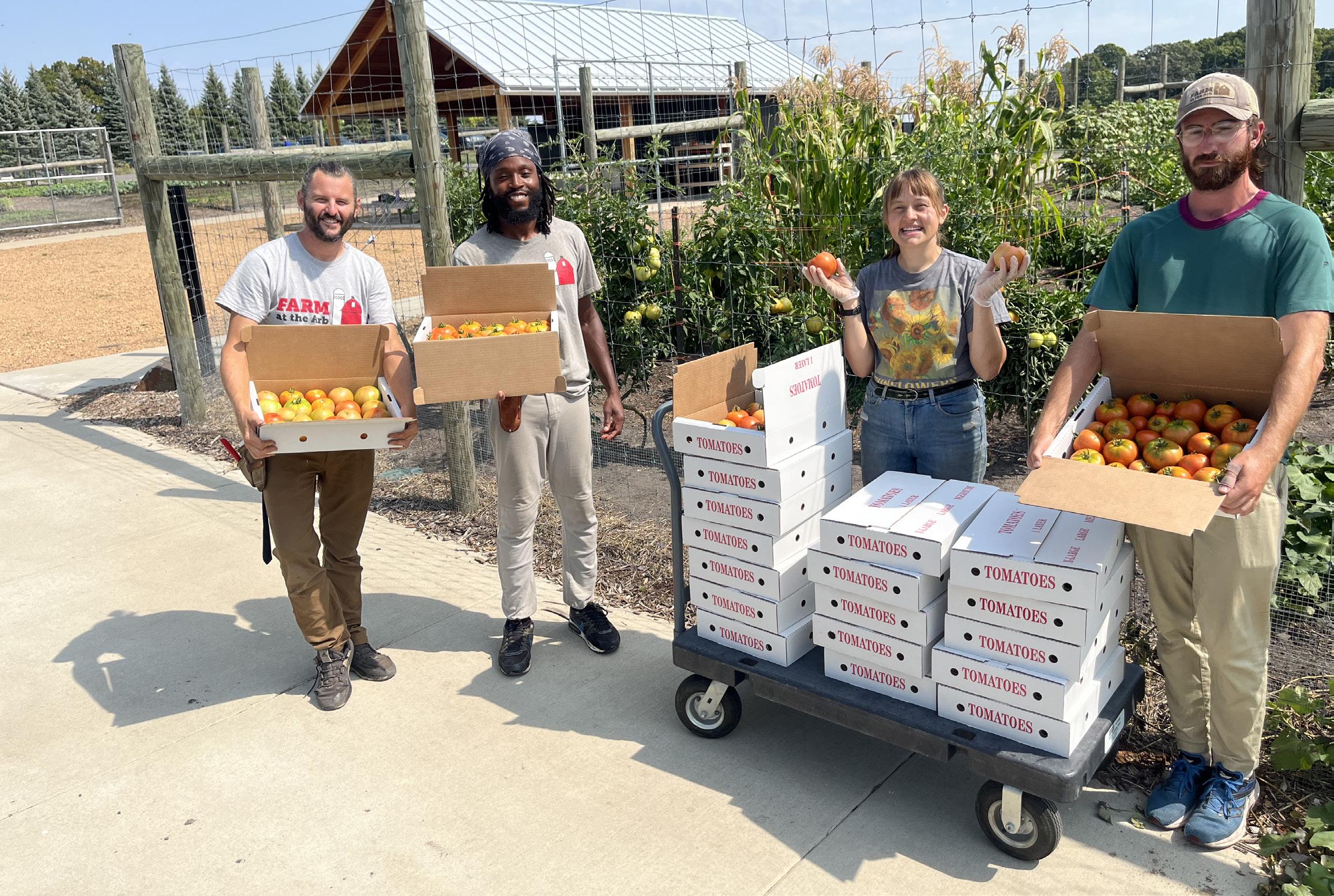
DEREK CARWOOD • ADULT EDUCATION MANAGER
Over the past three years, a new program at the Farm at the Arb has been providing high-quality and nutritious foods to healthcare patients. The initiative, Veggie Rx, is designed as a tool to help prevent and manage chronic diseases by providing doctor-prescribed fresh fruits and vegetables, enhancing access to valuable resources and building community bonds.
Funded in part by grants from the USDA’s Gus Schumacher Nutrition Incentive Program, the fruits and vegetables grown at the Farm at the Arb are planted, tended and harvested by workers in the Farm at the Arb Apprenticeship Program. The program creates opportunities for career advancement and skill development for apprentices, making the program a mutually beneficial collaboration for everyone involved. While the Veggie Rx program is not meant
to replace traditional medicine prescribed by physicians, healthy foods supplement patients’ diets to improve health and ward off preventable diseases such as Type 2 diabetes, heart disease and other ailments often exacerbated by food insecurity. What’s more, in addition to the program’s physical health and nutrition goals, it is also designed to improve overall wellbeing.
As Susanne DePalma, Farm at the Arb Produce Coordinator, puts it, “Veggie Rx aims to address some of the social barriers to good health while building a community of support around healthy living.”
During the growing season, the program’s healthy harvests are made accessible to patients by distribution through pickup locations in Shakopee and Chaska. Bringing foods straight from the farm into the community helps improve
accessibility and demands less from patients.
Another unique aspect of the program is that the Veggie Rx prescription pickup sites are designed to mimic farmers markets to entice folks to stick around and create new, positive relationships. This holistic approach fosters the development of community cohesiveness and breaks down barriers that limit participants’ contact with healthcare professionals and Extension educators.
As part of a larger statewide initiative in collaboration with a number of community partners, the Veggie Rx program at the Farm has contributed thousands of pounds of fresh produce in just the first few years, helping hundreds of people to reach and sustain positive health goals. Stop by the Farm at the Arb to check out all of the amazing crops growing this season and chat with one of many apprentices hard at work in the fields.
SARAH JACKSON • PR / MEDIA SPECIALIST
The Minnesota Landscape
Arboretum is known for its elaborate displays of pumpkins, squash and gourds. With more than 400 varieties grown, harvested and arranged around the grounds — and sold at the popular AppleHouse 1.5 miles down the road — locals know that the Arboretum’s gourd game is strong every fall.
If you’d like a piece of art — that can last a lifetime — to celebrate the Arboretum’s impressive winter squash season, look no further than the fourth-annual Arboretum Glass Pumpkin Patch. Happening Sept. 13-15, this outdoor fundraiser organized by the Arboretum Auxiliary features more than 7,000 pumpkins of varying sizes, shapes and colors that visitors can purchase and enjoy all year long. Proceeds benefit the artists as well as Arboretum operations.
Created by a highly skilled, juried cadre of glassworkers from around the U.S., each of these incredible works of art are made with furnace-fired glass that’s dipped, spun, rolled, molded and blown into incredible gourd shapes, glass garden art and other items such as jewelry.
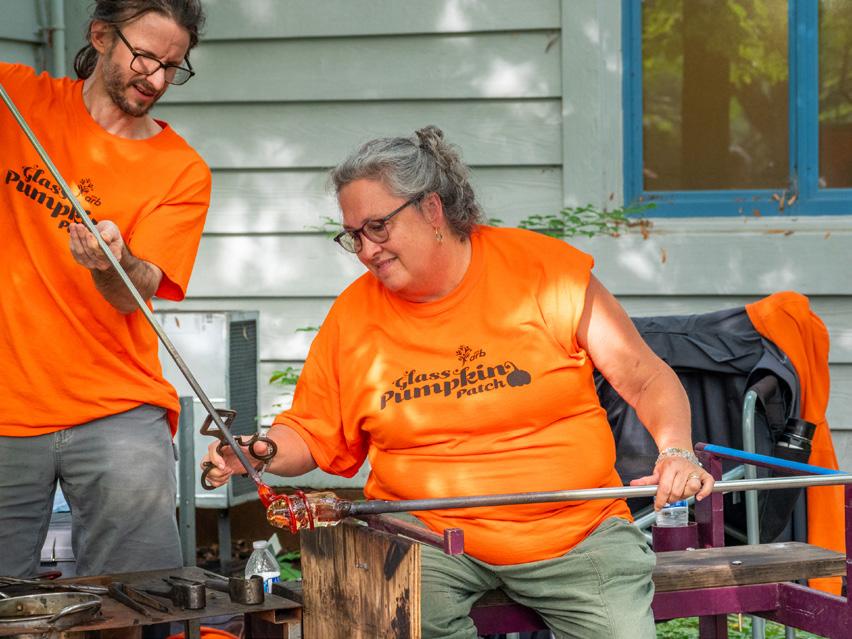
Many of the one-of-a-kind pieces let sunlight shine through — showing off their sparkling colors, textures, patterns and accents. Others are opaque and simply sparkle with mystery, thanks to colorful pieces of glass (known as frit) that each artist magically melts into the works during the glass-blowing process.
Most intriguing of all are the pumpkins’ stems, which the artists create by stretching and pulling tendrils of colorful hot glass that they then wind around steel rods before placing them carefully


on the shoulders of the pumpkins to dazzle forevermore.
All the featured glass artists are mythically talented "stem-i-gods" as the event's co-curator Shannon Jane Morgan likes to say. You may become a believer, too, if you stop to watch the
Handcrafted glass pumpkins for sale at the fourth-annual Arboretum Glass Pumpkin Patch feature extraordinary colors and shapes that make each pumpkin a unique work of art.
glass-blowing demonstrations that take place throughout the three-day event.
Truly, the hardest part will be deciding which glass pumpkin (or pumpkins) you want to take home. Reserve a timeslot for your visit at arb.umn.edu/events/glass-pumpkin-patch.
Find a new way to explore the Arboretum in each season. In addition to 1,200 acres of gardens, plant collections and natural areas, the Arboretum offers a variety of events and activities to enrich your experience and deepen your connection with nature. Events are included with daily admission except where noted. Browse the full schedule of events online at arb.umn.edu/events

Sept. 7, 10 a.m.-3 p.m.
Presented by KWS Seeds, the annual Field Fest is a family-friendly event that celebrates the harvest at the Farm at the Arb with live music, food trucks and a beer garden! Visitors can dig into the soil to harvest sugar beets, corn and potatoes, and learn about agriculture through informative tours and hands-on games, activities and educational exhibits. Register for this free event, which includes access to the Arboretum, online.
Aug. 16, 4-8 p.m., Aug. 17-18, 10 a.m.-4 p.m.
Stroll the gardens of the Arboretum while browsing a unique showcase of art and nature, featuring more than 90 local vendors offering culinary treats, crafts, fine arts and more. Arboretum visitors can meet the artists, listen to live music, mingle, eat and shop.
Immerse yourself in the beauty of nature this season with the Arboretum’s Yoga in the Gardens series. Offered on select Thursdays and Sundays against the backdrop of the Arboretum’s gardens, this series invites participants to experience various yoga classes, including nia, slow flow, vinyasa, yin yoga, sound healing and more. Registration is $7.50 for members and $27.50 for non-members. Find the full schedule and reserve your tickets (required) online.
Sept. 21, 9 a.m.-3:15 p.m.
Relax your mind, body and spirit while embracing the start of the fall season at the Arboretum's Autumn Yoga Retreat. The retreat begins with a light breakfast at the Farm at the Arb followed by three different class rotations with a break for lunch. From vinyasa and yin classes to acupressure tapping and more, our Yoga in the Gardens partner studios offer something for everyone! The retreat will close with a blissful yoga nidra session. Reserve tickets (required) online.
Stock up on apples, treats, gifts and decor at the AppleHouse, opening in late August, depending on apple availability. The AppleHouse is located just down the road from the Arboretum’s main entrance at 7485 Rolling Acres Road next to the Horticultural Research Center. Shop a variety of popular University of Minnesota apple introductions, including Honeycrisp, SweeTango® and First Kiss®. All proceeds help support Arboretum research and operations. Check arb.umn.edu/apple-house for updates and the opening date.

Sept. 17, 7:30-10:30 p.m.
Join an after-hours experience to celebrate the September full moon with filmmaker and climate activist Charly Rose Bjørn Frisk at a screening of her documentary “Frø: Nordic Seed Heroes.” Learn how to save native seeds from The MN SEED Project and view a seed catalog display from the Andersen Horticultural Library before taking in views of the full moon on a candle-lit hike. Reserve tickets (required) online.

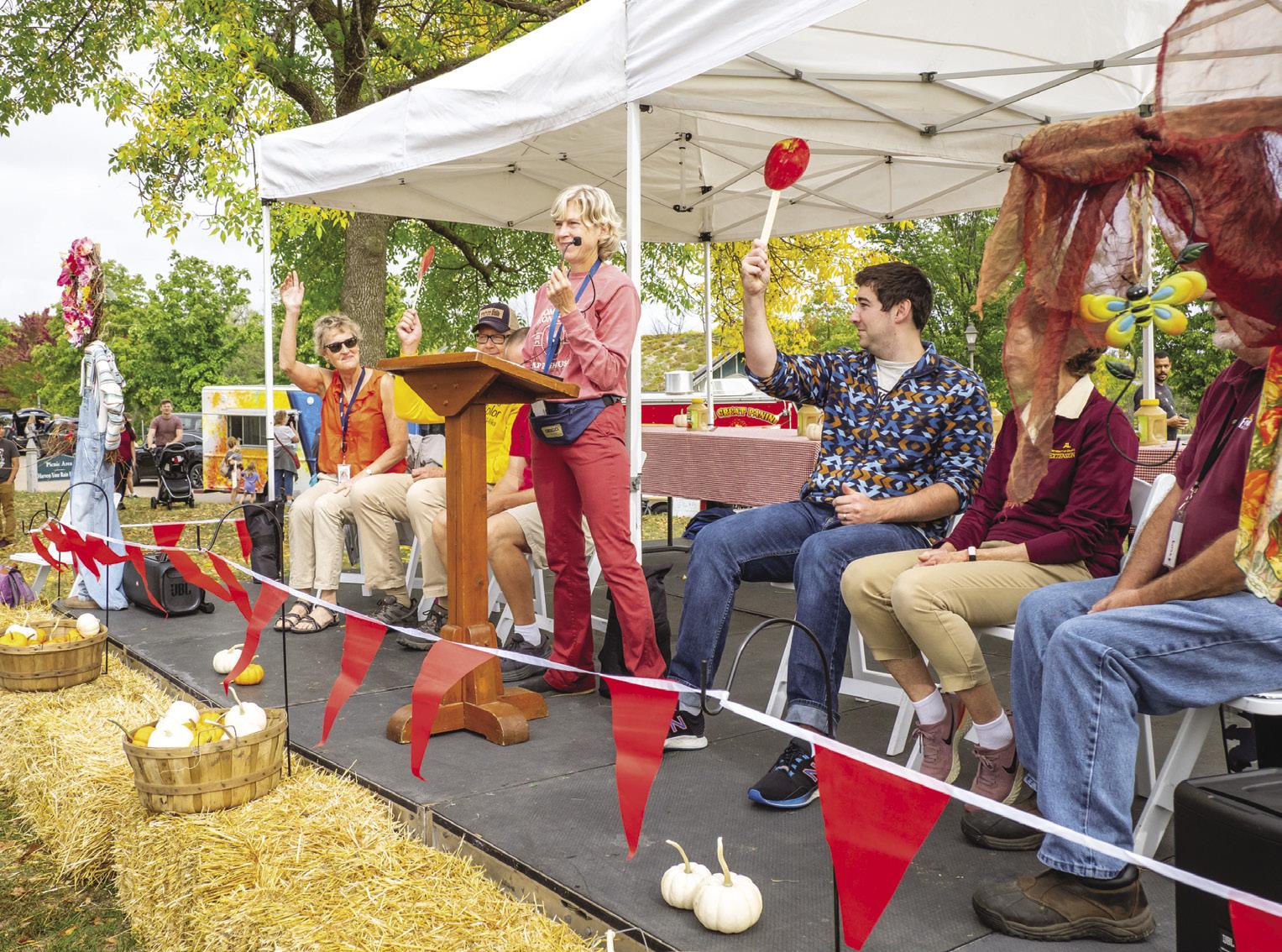
Sept. 28, 10 a.m.-4 p.m.
Oct. 11-13
Save the date to enjoy beautiful fall colors at the Arboretum! Pick your course (1K, 5K or 10K), date and start time and experience the wonder of autumn from trails lined with stunning fall foliage. This event is staggered over three days to prevent overcrowding of the trail space and maximize enjoyment for all participants. Register online (required) by Sept. 13 for a T-shirt in your preferred size.

Celebrate everything apple at the “Home of the Honeycrisp,” the Arboretum and Horticultural Research Center! Learn all about apple breeding, research, cider making and more from Arboretum experts and try your hand at an apple-peeling contest! Then enjoy fresh local food offerings, including applethemed fare. Reserve tickets (required) online.
Sept. 14-Oct. 31
Scarecrows add a festive note to the Dahlberg Terrace and Scarecrow Hill. Check out the artistry of the experts from Bachman’s, Arboretum staff and members of the community and vote for your favorites.
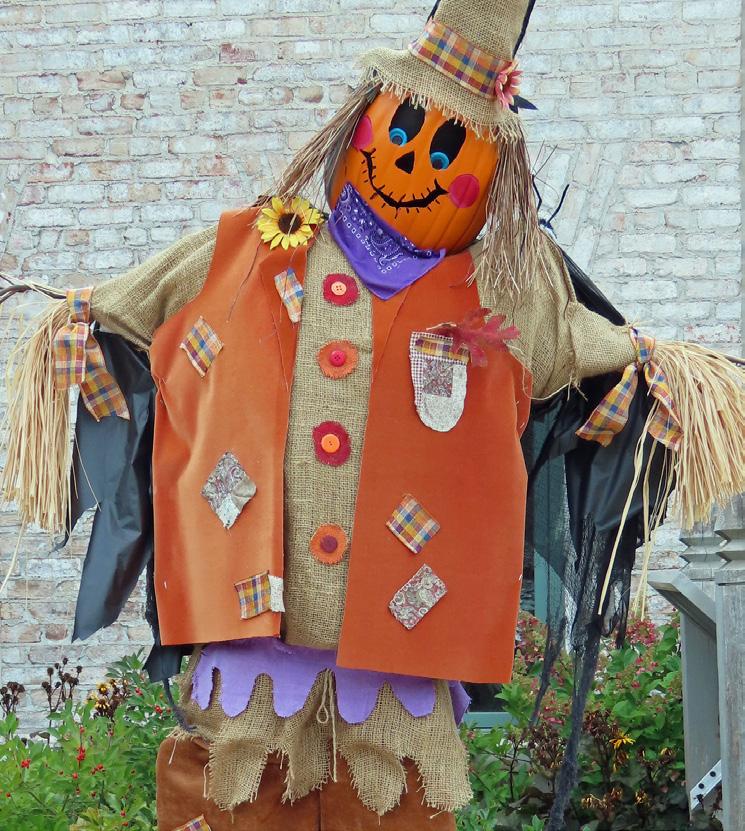
Oct. 4-6
Save the date to shop for a curated selection of used books and DVDs on a wide variety of subjects. Thanks to the support of the Arboretum community, this event, hosted by the Friends of the Andersen Horticultural Library, typically raises about $15,000 in support of the library. The library is accepting donations of new and gently used books of all genres (with some exceptions), DVDs and puzzles through Aug. 15.
Oct. 4-6
Mark your calendars for the annual Arboretum Auxiliary Harvest Sale, offering nature-inspired items including home decor, potpourri, Arboretum wood creations, knitwear for adults and children, beautiful autumnal wreaths and arrangements, and many other creative arts. All items are handcrafted by Auxiliary members, and all proceeds benefit the Arboretum.
April 26-May 6, 2025
Discover the spectacular gardens and diverse ecosystems of mainland Ecuador on this 11-day trip that includes a luxurious 5-day cruise around Darwin’s Galapagos Islands. Join Executive Director of the Minnesota Landscape Arboretum, Andrew Gapinski, along with excellent local naturalist guides on this once-in-a-lifetime adventure. Experience unique cultural interactions, explore the cloud forest’s plants and orchids and walk among more than 130 hummingbird species, in addition to seeing giant tortoises, colonies of iguanas, blue-footed boobies and much more! Learn more and register at arb.umn.edu/travel
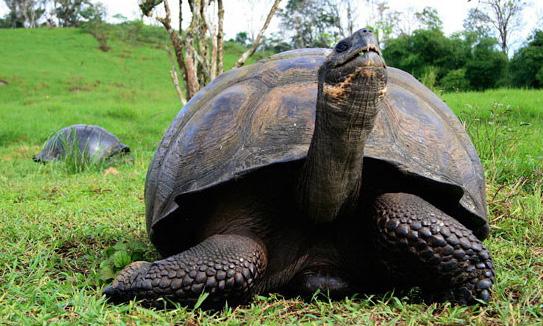
The Arboretum is a wonderful place to learn, thanks to a variety of experts, scenery and plant collections. Prices listed are for members/non-members respectively. See a complete list of classes for adults, children and families at arb.umn.edu/learn. Register online or call 612-301-1210.

8-Session Class, Aug. 7-Sept. 25, 9-11 a.m.
Learn the art of creating beautiful botanical artwork using a limited palette of watercolors. As you paint a blueberry branch in full detail, you will learn how to underpaint to create form, glaze to create vibrant colors, stipple to create texture and negatively paint veins on leaves. Botanical art takes time and patience, but the reward is creating realistic and scientifically accurate fine art! Cost is $272/$320.
Aug. 1 or Sept. 5, 2-3:30 p.m.
Experience the science behind the healing power of nature. Each Wonder Filled Experience features a different seasonal theme based on what’s in bloom and includes a discussion on biophilia to help participants develop a connection with nature — an essential part of health and wellbeing. Breathing and grounding exercises will help calm the mind and enhance time spent in a natural environment. Cost is $22/$37
Aug. 3, 17, Sept. 7, 21, drop-in activities available between 9:30-11:30 a.m.
Dig into nature by spending time in the garden! Ages 5-11, together with an adult, will explore seasonally themed activity stations, including scavenger hunts, garden-inspired creative art projects and tasks such as planting, watering, weeding and harvesting. Participants will develop science observation skills using microscopes and hand lenses. Activities change week to week as the garden grows and changes. Cost is $12 per child.

Aug. 3, 10 a.m.-noon
Get your boots wet and learn about habitat restoration efforts and wetland management taking place around Green Heron Pond from Arboretum experts. After a presentation on wetland ecology, invasive plants and habitat restoration techniques, get a behind-the-scenes look at the surrounding wetlands. Explore this unique ecosystem and the native plants that call it home, including pitcher plants, rare orchids and tamaracks. Cost is $25/$40.
Aug. 3 or Sept. 14
Create a delightful handmade gift for yourself or a loved one as you enjoy the relaxing SAORI weaving experience. This contemporary weaving method, founded in Japan in 1968, is a gentle, immersive process emphasizing improvisation and creative expression. SAORI is a compound word meaning "weaving with individual dignity." Weavers will use a simple foot-powered loom, perfect for beginners! Cost is $99/129, including supplies.

Aug. 8, 2-3:30 p.m.
Slow down and explore the world of insects! Join entomologist Val Cervenka to explore nature from a bug's-eye view and deepen your appreciation of the insects that make up the web of life in our world. Discuss biophilia to understand how a connection with nature is essential for our health and wellbeing. Learn what defines an insect and how to look for evidence of insects and visit the Wildflower and Sensory Gardens to discover insects in their natural environments, then witness their beauty up close under a high-powered microscope. Cost is $22/$37.

Aug. 11, 10:30-11:45 a.m.
Ages 6 and older are invited to don a beekeeping suit and join Arboretum beekeeper Ping Honzay at the Tashjian Bee and Pollinator Discovery Center for a close-up look at the inner workings of a honey bee hive. Hold a frame of bees if you dare! Learn about the life of a hive and beekeepers’ work with these fascinating creatures. Cost is $29/$44, including a beekeeping suit and gloves to borrow during the program.

Sept. 8, 9 a.m.-1 p.m.
Catch the buzz … on camera! Learn techniques for capturing stunning images of beneficial insects — without frightening them away! Discuss fundamentals such as focus techniques, composition, shutter speeds, lens selection, techniques for holding the camera steady and how to capture insects while perched or in flight. Cost is $105/$120 and includes classroom instruction plus in-the-field practice.
Sept. 18, 9 a.m.-noon
Join Chef Beth Fisher and horticulture experts in a small group garden-to-plate hands-on culinary experience. Immerse yourself in the art of growing and harvesting a diverse array of ingredients from the bountiful Foodscape that surrounds the Myers Education Center. Afterward, come into the Kitchen Classroom and learn how to create an innovative recipe that celebrates the freshness of these harvested treasures. Cost is $145/$165.

Sept. 28, 9 a.m.-1 p.m.
Make the most of your photography during beautiful fall days. Discuss the fundamentals of landscape photography, including planning a photography outing, camera settings, composition, coping with the elements, post-processing and the hyperfocal point. Following the lecture, practice the concepts covered in class on a photo hike with the instructor. Cost is $95/$110.

3675 Arboretum Drive
Chaska, Minnesota 55318-9613
The Arboretum is now on TikTok! Follow us @mnarboretum.





For more information on upcoming art exhibitions — including Meet & Greet events — visit arb.umn.edu/art.
Beyond Boundaries: An Exploration of Indigenous Art | Sept. 17-Nov. 17
Discover a world where culture, tradition and imagination intertwine. This exhibition, co-curated by artist Heather Friedli, features the work of seven Indigenous artists whose artistry lies beyond the confines of tradition. Working in a wide array of mediums, the artists in this exhibition transcend limitations and embrace creativity by implementing traditional techniques passed down through generations and layered with bold experimentation and modern interpretations. View the exhibition and meet the artists during a reception on Sept. 20 from 6-8 p.m.
Symbiosis in Nature: Sculptures by Annie Mariano | Through Sept. 7
Explore the Arboretum grounds in a whole new way during this exhibition of nature-inspired sculptures by metalwork artist Annie Mariano. Located throughout the Arboretum’s gardens, Mariano’s sculptures invite viewers to engage more deeply with nature — exploring themes of symbiosis in nature and between art and nature itself.
Bringing the Outdoors In | Aug. 29-Oct. 29
Artists Rachele Krivichi and Deanna Mayer immerse themselves in the outdoors, noticing colors, textures and materials to create artwork that transforms and enriches the indoor space by bringing elements of nature indoors. Krivichi’s multimedia works in acrylic and collage illustrate the interplay between nature and the intimate world of the interior, providing a counterpoint to Mayer’s botanical bas-relief sculptures that seem to capture and preserve a moment in time.
Poster Palooza | Sept. 6-Jan. 24
This showcase of student creativity and library joy celebrates 50 years of the Andersen Horticultural Library at the Arboretum! University of Minnesota College of Design students bring the library's unique collections to life through vibrant posters designed in a surface design course led by Professor James Boyd Brent. Join us in marking this momentous occasion with these colorful posters that illustrate the fascinating stories behind the Arboretum’s books and botanicals.

“The Bird Watcher’s Living Room” by artist Rachele Krivichi from the exhibition “Bringing the Outdoors In” will be on display in the Cafe Gallery Aug. 29-Oct. 29.